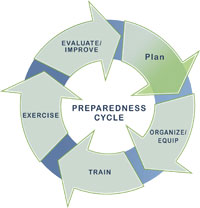Plan

Planning makes it possible to manage the entire life cycle of a potential crisis. Strategic and operational planning establishes priorities, identifies expected levels of performance and capability requirements, provides the standard for assessing capabilities, and helps stakeholders learn their roles. The planning elements identify what an organization’s Standard Operating Procedures (SOP) or Emergency Operations Plans (EOP) should include for ensuring that contingencies are in place for delivering the capability during a large-scale disaster.
The National Response Framework presents the guiding principles that enable all response partners to prepare for and provide a unified national response to disasters and emergencies - from the smallest incident to the largest catastrophe. The Framework establishes a comprehensive, national, all-hazards approach to domestic incident response.
Integrated Planning System
The Integrated Planning System (IPS) is being developed to coordinate and harmonize planning efforts across the Federal government as well as among Federal, State, local, tribal, and territorial partners.
Preparedness Technical Assistance
Preparedness technical assistance (TA) services seek to build and sustain capabilities in support of the preparedness mission area. These services address the suite of priorities and capabilities outlined in the National Preparedness Guidelines. As capability gaps are identified within State and local jurisdictions, Preparedness TA services are designed, developed, and delivered to address those needs and build capabilities in the most critical areas.
Comprehensive Preparedness Guide 101
The FEMA Comprehensive Preparedness Guide (CPG) 101 provides general guidelines on developing Emergency Operations Plans (EOPs). It promotes a common understanding of the fundamentals of planning and decision making to help emergency planners examine a hazard and produce integrated, coordinated, and synchronized plans.
Comprehensive Preparedness Guide 301
The FEMA Comprehensive Preparedness Guide (CPG) 301 provides recommendations for planning for special needs populations. This guide offers scalable recommendations to meet the needs of different jurisdictions based on factors such as size, risks, and hazards.
Regional Catastrophic Preparedness Grants
The FY 2009 Regional Catastrophic Preparedness Grants (RCPGP) is intended to support coordination of regional all-hazard planning for catastrophic events, including the development of integrated planning communities, plans, protocols, and procedures to manage a catastrophic event.
Last Modified: Thursday, 09-Apr-2009 11:51:39 EDT
